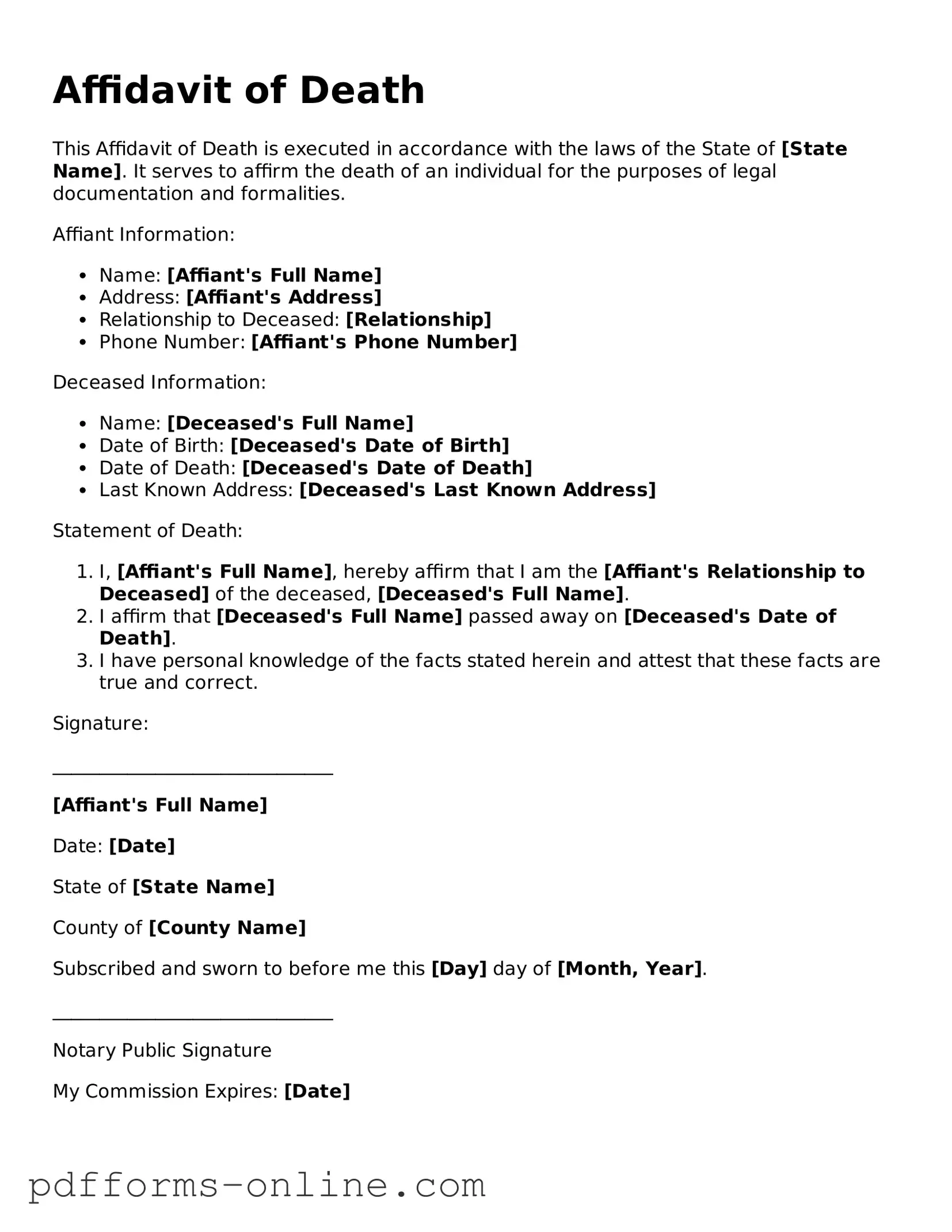The Affidavit of Death form serves a specific purpose in legal matters, particularly in confirming the passing of an individual. Similar to this document is the Death Certificate. A Death Certificate is an official record issued by a government authority, typically a vital statistics office, that confirms the death of a person. It includes essential details such as the deceased's name, date of birth, date of death, and the cause of death. While the Affidavit of Death may be used in various legal proceedings, the Death Certificate is often required for settling estates and claiming life insurance benefits.
Another document that shares similarities is the Will. A Will outlines how a person wishes their assets to be distributed after their death. Like the Affidavit of Death, a Will is crucial in the probate process. It provides clarity on the deceased's intentions and can help prevent disputes among heirs. Both documents play significant roles in managing the affairs of the deceased, though the Will focuses on asset distribution while the Affidavit of Death confirms the individual’s passing.
The Statement of Death is also comparable. This document is often used in financial and insurance contexts to notify companies of an individual's death. It serves a similar function to the Affidavit of Death by providing proof of death, but it is typically less formal and may not require notarization. The Statement of Death helps expedite the process of settling accounts and claims, making it an essential document for beneficiaries.
In navigating the complexities of end-of-life documents, individuals may also consider the importance of a Living Will, which is crucial in expressing one's healthcare preferences in situations where they cannot communicate. For those looking to manage their medical decisions proactively, completing the Living Will form in Arizona can be an essential step; for more information, visit All Arizona Forms.
The Probate Petition is another related document. This legal filing initiates the probate process, allowing for the distribution of the deceased's estate. The Affidavit of Death may accompany a Probate Petition to establish that the individual has indeed passed away. Both documents are integral to settling an estate, but the Probate Petition encompasses a broader scope, addressing the administration of the deceased's assets.
A Power of Attorney (POA) can also be seen as similar, although it serves a different purpose. A POA designates an individual to make decisions on behalf of another person while they are alive. However, when the person passes away, the authority granted by the POA ends. In some cases, the Affidavit of Death may be needed to terminate the powers granted under a POA, thereby linking the two documents in the context of managing legal affairs after death.
The Living Trust is another document that shares some similarities. A Living Trust allows individuals to manage their assets during their lifetime and specifies how those assets should be distributed upon their death. When the individual passes away, the Affidavit of Death may be required to transfer assets from the trust to the beneficiaries. Both documents work together to ensure that the deceased's wishes are honored and that the transfer of assets is handled smoothly.
Next, the Certificate of Heirship is relevant in this context. This document establishes the heirs of a deceased person when there is no Will. It is often used in situations where the estate needs to be settled without formal probate. The Affidavit of Death may be included with a Certificate of Heirship to confirm the death of the individual in question. Both documents aim to clarify the distribution of assets and the rightful heirs.
The Letter of Administration is another document that can be likened to the Affidavit of Death. This letter is issued by a court to appoint an administrator to manage the estate of a deceased person who did not leave a Will. The Affidavit of Death may be required to support the request for this letter, as it provides official confirmation of the individual's passing. Both documents facilitate the legal process of settling an estate when there is no clear directive from the deceased.
Finally, the Release of Liability form can be considered similar in certain contexts. This document is often used to absolve one party of legal responsibility in the event of a claim or lawsuit. In cases involving wrongful death claims, an Affidavit of Death may be required to substantiate the claim, while a Release of Liability may be signed by the beneficiaries to settle the matter. Both documents play important roles in resolving legal issues surrounding death, albeit in different circumstances.
